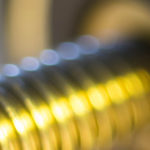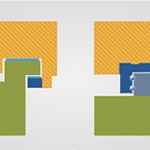Dovetail slides are a type of plain linear bearing — along with boxway slides and plain bushings made of plastic, composite, or bronze — that rely on direct contact between sliding surfaces to support a load. These differ from modern rolling element linear bearings, which use balls or rollers to reduce friction between the load-bearing surfaces.

Image credit: Alexander Slocum
In the family of plain bearings, boxways generally have the highest load capacities and are commonly used in applications such as machine tools and stamping machines. But boxway designs require more contact surfaces, which must be machined for proper operation, making them more difficult and manufacture, and in turn, typically the most expensive option. Plain bushings can be made from a wide range of materials, so they can be applied in a variety of applications with contamination, chemicals, and environmental hazards. But they have poor stiffness and lower load capacities than boxways or dovetail slides.
Rolling element guide or dovetail slide?
With high load capacities and good stiffness, dovetail slides can be used in many of the same applications and operations as profiled rail-type guides and crossed roller slides. But dovetail slides, with full contact between the machined surfaces of the base and saddle, typically have higher stiffness and higher load capacity than similar-sized rolling element guides, which operate with only point contact (ball types) or line contact (roller types) between the rolling elements and the raceway. The full-contact design of the sliding surfaces, or ways, also makes dovetail slides well-suited for absorbing and damping shocks and vibrations, which would damage ball or roller bearings.

Image credit: Gilman Precision
However, this full contact design also means that sliding friction is higher for dovetail designs than for ball or roller bearing guides. Like all metal-on-metal contact bearings, lubrication is critical for proper operation of dovetail slides, and oil (rather than grease) is required to ensure a proper lubricating film between the surfaces, which reduces friction and ensures long life.
Like profiled rail and crossed roller slides, dovetail slides can withstand loads from any direction, although load capacities are higher for downward loads than for upward loads due to the geometry of the dovetail design. Since there are no rolling elements in a dovetail slide, the typical L10 bearing life equation doesn’t apply. Instead, sizing is simply a matter of comparing the static and dynamic load on the bearing to the capacity ratings of the slide.
Materials and designs
The most common material used for dovetail slides is normalized cast iron, but other materials are suitable. For example, aluminum versions fill a need for lower-weight assemblies, when lower load capacity is acceptable, and stainless steel versions are available for highly corrosive environments. Some manufacturers also offer slides with a low-friction material — commonly PTFE — on the ways, to reduce dynamic friction and stiction.
Dovetail slides are generally available in two designs: low-profile and high-profile. Low-profile versions have thinner bases and saddles and are the general-purpose choice for moderate loads and rigidity requirements. High-profile versions have thicker bases and saddles, which provides higher stiffness against deflection. After assembly, the base and saddle are machined to ensure flatness and parallelism between the mounting surface and the top of the saddle. And in all but the lowest-precision designs, the ways are ground or hand-scraped to reduce friction and further improve travel accuracy.

Image credit: ERO-Führungen GmbH
While preloading isn’t possible with dovetail slides, clearance between the way surfaces can be adjusted via a gib, which is a ground steel spacer that runs the length of the saddle. Once the clearance is set, gib screws lock the gib in place. This ability to adjust the slide is probably the most significant benefit of dovetail slides over boxway types.

Image credit: Setco Inc.
When used in gauging, machining, or inspection applications, dovetail slides are commonly driven by a hand crank or dial connected to a lead screw. But for automated applications, designers can choose from lead screw, ball screw, pneumatic, or even hydraulic drives.
Lead screw and ball screw driven slides are often provided as integrated assemblies from the slide manufacturer, while pneumatic and hydraulic drives are commonly integrated by the OEM or end user. Similarly, many dovetail slide manufacturers offer multi axis arrangements as standard options — either as integrated assemblies, or as ready-to-assemble components with the required brackets and mounting holes.
Feature image credit: Norelem







Leave a Reply
You must be logged in to post a comment.